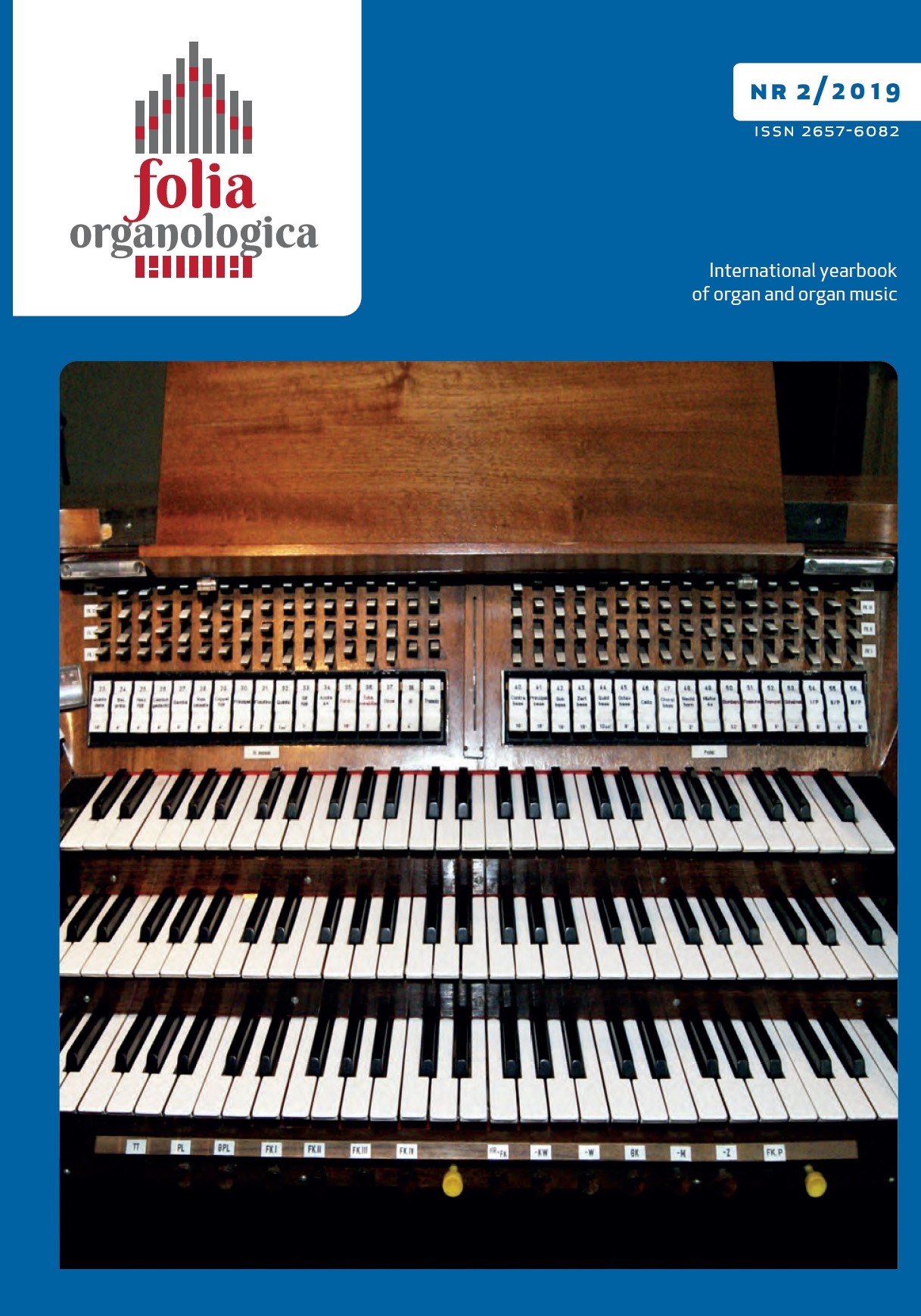Historia organów firmy Rieger w kościołach jezuickich na terenie Krakowa
History of the Rieger Organs in Jesuit Churches of Kraków
Author(s): Piotr MatogaSubject(s): Cultural history, Music
Published by: Uniwersytet Opolski
Keywords: organ;organ building;organ makers;Kraków;Rieger
Summary/Abstract: History and activity of the Rieger company were the subject of several publications using, among others, catalogues and advertisements published by the company. The article concerns the history of pipe organs of the company in two Jesuit churches of Kraków: St Barbara’s Church and the Sacred Heart’s Church. The beginning of development of music in the Jesuit order took place under the rule of the general Claudio Acquaviva, who at the beginning, in 1608, allowed to use the pipe organ and woodwind instruments in churches, and yet in 1611 he agreed to employ secular instructors of music, what next allowed to establish music schools. The musical chapel, active in Kraków from the 17th century and competing with the chapel of St Mary’s Basilica, was an important element of Jesuit activity in the field of music.St Barbara’s Church was created through rebuilding the 14th-century cemetery chapel at the St Mary’s Basilica’s Cemetery. In 1583, the church was given to Jesuits, who discovered an organ in it. The new instrument, finished in 1688, was sold in 1731 and replaced by a significantly smaller one, and then the next one, built in 1865 by Antoni Sapalski. In order to build the new organ, which has been preserved until today, the monks contacted the company of Gebrüder Rieger from Jägerndorf, which in 1894 presented the first project of the disposition, and then the official cost estimated model. Yet in December 1894 the final acceptance of the mechanic instrument (Opus 457) with two keyboards and pedal took place. It was equipped with 16 ranks, including 5 in the multiplex system.In 1913, the organ was equipped with the electric motor. Moreover, two pipes were changed then. In 1917 and 1918 Stanisław Żebrowski from Kraków made the repair. In June 1918 pipes from the case were taken to be used for war purposes. The person who removed them was Josef Kloss, the technical director of the Rieger company, who went to Kraków to undertake similar actions in other churches of the city as well. During his stay, he lived in the Jesuit monastery at the St Barbara’s Church. In 1919 S. Żebrowski cleaned and tuned the organ. In February 1920 he installed the missing pipes of the case, commissioned from the Rieger company. The same organ builder had a conflict with the general of Jesuits in 1927. The reason for that was that he did the works beyond the written agreement, demanding additional payment. In 1935 the overview of the instrument was made by the Rieger company. In 1964, in the face of the deterioration of the organ, the representative of the Dominik Biernacki of Warsaw’s company, made an overview. The company offered the repair connected with the reconstruction in terms of changing the tracker action, organ’s console and adding “modern” pipes. The works were not realised. In 2007–2009 the church was thoroughly rebuilt. Then, the repair of the instrument took place as well, made by the company of Michał Klepacki from Pępów. The monumental Sacred Heart’s Church in the district of Wesoła was built by Jesuits in 1909–1912, replacing the previous chapel. In the 1920s the offers to build the pipe organ in a new church were made by the following companies: Gebrüder Rieger (1923–1924), Wojciech Zagórda from Czernichów (1925), Joseph Goebel from Gdańsk (1927) and Dominik Biernacki from Włocławek (lack of date). Finally, in November 1927, Jesuits commissioned the instrument from the company of Rieger. Its parts arrived in the church in May 1928 and yet at the beginning of June the final acceptance of the organ took place in the presence of Cracovian musicians: Bolesław Wallek-Walewski and Tomasz Flasza. The ceremony of consecration of the new instrument (Opus 2317) took place on 10th June 1928. Firstly, the organ had 33 ranks, 3 manual keyboards, a pedal and pneumatic tracer action.The instrument was probably damaged as a result of explosions in 1945. It was repaired by the Rieger company in 1947. First serious works with the organ are not scrupulously documented. It is known that on 18th November 1956 the consecration of the instrument after the renovation under the guidance of Prof. Józef Chwedczuk took place. The executor of the works was probably the company of Wacław Biernacki from Kraków. Then. The number of voices was extended to 45, and tracker action was replaced by an electro-pneumatic one. In 1972 the pipe organ was tuned and in 1981 several repairs were made by Lech Skoczylas from Kraków. In 1989 the repair was made by Albert Kunz and Lech Skoczylas from Kraków. In 2007 the reconstruction was made by Michał Klepacki from Pępów after the consultations with Jerzy Kukla from Lublin. The number of voices increased to 47, new bellows were built, the console was installed as well as electronic memory system. The earlier organ console of the Rieger company is currently kept in the side part of the gallery.The presented article proves that the Rieger company with its seat in Silesia to some extent shaped the picture of organ building in the territory of Southern Poland since the end of the 19th century.
Journal: Folia Organologica. International yearbook of organ and organ music
- Issue Year: 2019
- Issue No: 2
- Page Range: 51-69
- Page Count: 19
- Language: English, Polish

